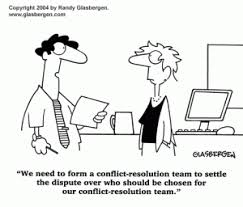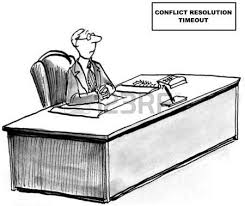Introduction
You spend eight hours a day with colleagues. You often see them more than some family members or friends. Logically, therefore, the cooperation does  not always go smoothly and irritations might arise. However, a collision does not have to have any negative consequences and can even clear the air. Provided, of course, the action is being taken in the right way. If this does not happen, disagreements and irritations can result in a real conflict.
not always go smoothly and irritations might arise. However, a collision does not have to have any negative consequences and can even clear the air. Provided, of course, the action is being taken in the right way. If this does not happen, disagreements and irritations can result in a real conflict.
Conflict
I am going to explain here what a conflict is, what managers can do and how a good conflict handling interview can steer things in the right direction. How to deal with conflicts at the workplace is a part of normal work situations.
If you hate these situations anyway, what do you do? I am proposing you become your own boss and start working from home. Check out the last paragraph!
Definition
There is a labor conflict if an individual or group is involved in a labor organization and another person or group feels frustrated or thwarted by them. This conflict should be related to:
- job content;
- work relations;
- working conditions;
- employment conditions.
Manager’s tasks
As a manager, you must ensure a safe and pleasant working environment. You have to follow a two-fold responsibility:
- You must bring conflicts between employees and parties out into the open and have to motivate them to come up with a solution;
- In addition, you may not ignore conflicts that are related to the style of management. The latter requires the courage to recognize that there is a conflict and that you play a part in it yourself. You may need to ask for advice or support, for example from a senior manager or a staff consultant.
Style of management
Your style of management has a major influence on whether or not conflicts arise:
- employees who feel that they have the support and trust of their supervisor, are better able to deal with conflicts of interest and different visions. With appreciation and recognition comes self-confidence and motivation;
- conversely, the lack of trust can be a source of labor conflicts. It is therefore important to note disturbing results of staff surveys on this point, conduct well-being surveys and employee satisfaction surveys very seriously to take timely measures;
- it is important that you do not only address (potential) conflicts and contradictions but do so in a constructive way directed to discuss and solve. Handle a style of leadership that is focused on addressing and solving.
Preventing conflicts
Here are the management characteristics that prevent conflicts, they do not  weed them out but keep them to a minimum:
weed them out but keep them to a minimum:
- communicate clearly and openly;
- appoint positive and negative performance aspects and record them;
- be clear about material aspects and working conditions, speak clearly about your own expectations and do not give false expectations to employees;
- be clear about responsibilities and record them;
- pay attention to the future perspective of employees through work, training and supervision plans;
- inform employees about developments within the organization in a timely manner.
Intervention options in labor disputes
How you can best intervene depends on the nature of the conflict:
If there is a (mutual) conflict among employees:
- engage with the people involved;
- bring the people involved into conversation, let them introduce themselves as much as possible
- come to a solution;
- make clear agreements about the progress and record it;
- if necessary, ask the personnel department for support;
If you yourself have a conflict with an employee:
- name the (potential) conflict;
- discuss in mutual consultation which way you will follow to get out;
- remember that you are in a more powerful position and that this could be threatening to the employee;
- mutually discuss who you are going to ask for support: the personnel adviser / HR department or a company social worker on the method to be followed;
In acute, violent conflicts:
- if necessary, arrange in consultation with the personnel consultant or your
 own manager, a time-out to prevent unpleasant escalations and to build in a cooling period;
own manager, a time-out to prevent unpleasant escalations and to build in a cooling period; - ensure that clear agreements are made about the further approach to the conflict (when will the next meeting take place, with whom, et cetera).
Involving a mediator is also a possibility in all cases above, provided that both parties are in agreement about this possibility. You can think of an internal or external mediator. Furthermore, you can think of a conflict-handling interview.
What is a conflict-handling interview?
A conflict handling interview is a negotiation with the aim to bring two quarreling parties together again. During such a conversation you not only map out the problem (cause of the conflict), but also each other’s interests and objectives. This is ultimately to achieve a solution together and to create a basis for future cooperation.
A conflict management interview can significantly increase your job satisfaction and motivation. It is a step towards a better relationship with a colleague. The better the cooperation goes, the better you can function.
What parts does a conflict management interview consist of?
A conflict management interview often consists of six parts. With the majority of the components, the manager/mediator is in control.
1 Introduction
Begin the conversation by mentioning the goal: finding a solution to the conflict and restoring the cooperation. To achieve this goal, all parties must  listen carefully to each other. You, therefore, mention the most important do’s and don’ts when it comes to giving feedback. An important rule is to talk in the I-form instead of the you-form. So ‘I find it difficult to communicate with you’ and not ‘you can not talk’. Also, state the history of the interview and explain again how the interview will proceed (procedure).
listen carefully to each other. You, therefore, mention the most important do’s and don’ts when it comes to giving feedback. An important rule is to talk in the I-form instead of the you-form. So ‘I find it difficult to communicate with you’ and not ‘you can not talk’. Also, state the history of the interview and explain again how the interview will proceed (procedure).
2. Vision of the mediator
You summarize the individual discussions as clearly and neutrally as possible. Avoid passing judgment. Try to mention facts in your analysis. For example: “Dick has trouble with the role of Joe as chairman during meetings. He feels inhibited by him when he inserts his points. “
3. Reactions to the quarrels
As a mediator you now have to be alert; this is the moment when most emotions come loose and you have to keep the control tight in your hands. Give both parties the opportunity to formulate the problem from their perspective. Make sure they listen to each other and that criticism is substantiated.
Ask for concrete examples. What do you mean exactly? What did that look like? Summarize reactions regularly and check whether the other party has understood them well. “What is he trying to say now?” If the parties get bogged down in an undirected discussion, take action. You can structure the conversation by writing down the most important bottlenecks, for example on a flipchart.
4. Identify causes
On the basis of the list, you just made, you jointly go through all the bottlenecks noted. Check with each bottleneck whether both parties can find themselves in the description. Arrange the bottlenecks if necessary in terms of importance. The biggest problem originator is at the top of the list. Also , involve the interests of both parties.
, involve the interests of both parties.
Is it in favor of one of the parties to behave in a certain way? What importance does he intend to serve by giving the colleague little room in a meeting? Can that interest also be defended in a way without the colleague being affected? And above all: what common interests can both parties mention?
5. Design and choose solutions
Again follow the list of bottlenecks. Now formulate a solution for each bottleneck. Both parties ask you to submit suggestions. You will note these all. You then discuss the suggestions and eventually you jointly choose a solution. Then check whether there is enough support for a solution. If this is not the case, again emphasize the common goal: resolving the conflict. A stubborn attitude of an employee can be changed by asking questions such as: “What would you like to do to improve the cooperation?”
6. Closing
Create an action plan together. You describe what steps have to be taken, who will do what, when something has to be done. You also agree on a date for an evaluation meeting to see if the chosen solutions work.
Conclusions
If you are working with people in whatever organization or company, conflicts are bound to happen. We are all humans after all and differ greatly from each other. Companies and their management had better policies in place to deal with conflicts at an early stage, so as not to let them grow to something insurmountable. There are various ways employers and employees can follow in order to resolve potentially big threats.

Conflicts not resolved?
I hope you work for a company that really deals with conflicts, however, if they are not, things might get out of hand to the point where it is advisable for you to leave the company. In that case, I am proposing to you to become your own boss by starting your own internet business. Read all about this unique opportunity offered by the world’s best internet business support program by clicking on my full review of them here.
In case you have any questions, please leave them in the comment boxes and I will come back to you within 24 hours.


Wow. These are some great suggestions on having successful experiences at work. I have not had any issues getting along with my co-workers. My BOSSES on the other hand, have been a Bane to my existence. That’s why I decided to start my own business since apparently I work better on my own. I just wish that I had access to this advice back then when I was in the general workforce.
Everyone of us who is part of the work force sooner or later encounters conflict at work. Many a time it is the bosses who are to blame for those quarrels. As I indicated a lot of things can be done to try and solve the situation, but if you happen to have the wrong management, which is so often the case, you better take leave. Becoming your own boss is the probably the best option.